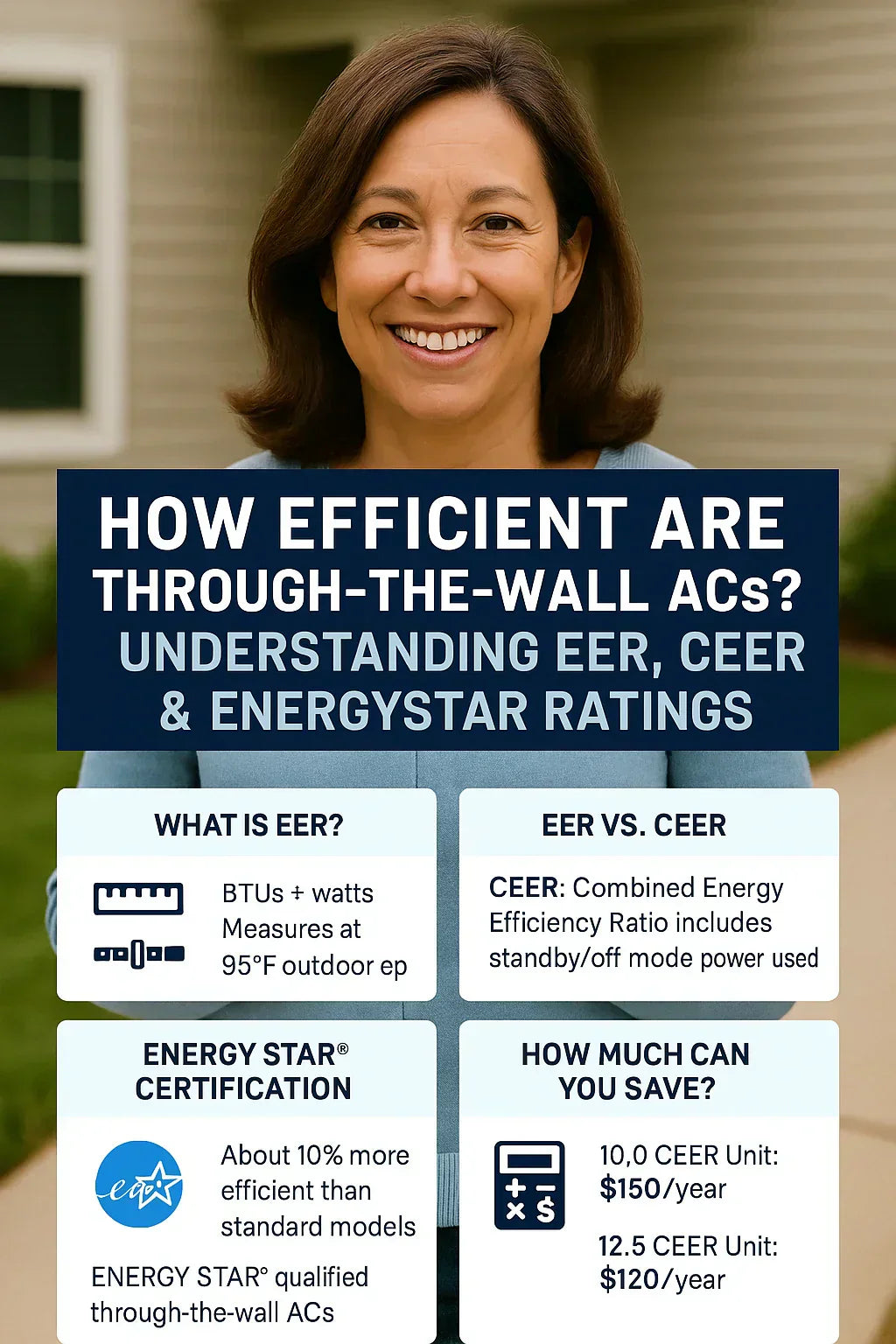Through-the-wall air conditioners (TTW ACs) have long been a go-to option for homeowners and property managers who want a space-saving cooling solution. But how do they stack up when it comes to energy efficiency?
If you’re wondering whether these units will spike your energy bill or save you money in the long run, this guide is for you. Samantha Reyes breaks down what you need to know about EER, CEER, and EnergyStar ratings before choosing your unit.
📊 What Is EER and Why Does It Matter?
EER (Energy Efficiency Ratio) is a simple calculation: it divides a unit’s BTU (cooling power) by its power consumption in watts. The higher the EER, the more efficient the unit.
For example, if a through-the-wall AC has a 12,000 BTU output and consumes 1,200 watts:
EER = 12,000 / 1,200 = 10.0Industry average for TTW units: 9.0–11.5.
Why it matters:
-
Directly affects your energy bill.
-
Useful for comparing units with the same BTU.
-
Not dependent on external conditions.
📉 What Is CEER and How Is It Different?
CEER (Combined Energy Efficiency Ratio) is the newer, more comprehensive metric introduced by the U.S. Department of Energy in 2014. It includes standby and off-mode energy use in the efficiency calculation.
CEER = Cooling Output (BTU) / (Operational Power + Standby Power)
Why CEER matters more in 2025:
-
Reflects real-world usage.
-
Required on all new EnergyGuide labels.
-
Especially relevant if your TTW AC includes smart or standby functions.
📘 Details from Energy Star CEER standards
🌟 What Is EnergyStar and Why Should You Care?
EnergyStar certification is awarded to appliances that meet strict energy-efficiency guidelines set by the EPA and DOE. As of 2025, TTW units must meet:
-
CEER ≥ 10.3 for units below 8,000 BTUs
-
CEER ≥ 9.8 for units 8,000–13,999 BTUs
-
CEER ≥ 9.4 for units 14,000+ BTUs
Benefits of EnergyStar units:
-
Lower electricity bills
-
Often qualify for rebates
-
May feature higher-quality components
💡 Why Through-the-Wall ACs Tend to Be More Efficient
Compared to window units, TTW air conditioners offer:
-
Permanent installation with sealed gaps (less energy loss)
-
Stable operation not affected by frequent moving or tilting
-
More advanced models with dual inverters and smart thermostats
For instance, GE and Friedrich models often include Eco Mode, Auto Restart, and Energy Saver settings—all designed to maximize CEER scores.
🧠 Smart Features That Boost Efficiency
Many 2025 through-the-wall models come equipped with:
-
Wi-Fi control for scheduling and remote shut-off
-
Humidity sensors that auto-adjust settings
-
Sleep mode that gradually reduces output overnight
📱 Why smart features help you save
🔄 When Efficiency Ratings Don’t Tell the Full Story
Sometimes a higher CEER or EER doesn’t equal savings:
-
Poor installation can cause air leakage
-
Wrong size means overworking or short cycling
-
Climate zone mismatch can skew expected performance
Always match BTU and CEER to your square footage and climate. Use a Sizing Guide to dial in your needs.
✅ Checklist: What to Look for in an Efficient TTW AC
-
✅ CEER rating over 9.5 (preferably over 10)
-
✅ EnergyStar label
-
✅ Eco Mode or Sleep Mode settings
-
✅ Inverter or dual-motor design
-
✅ Wi-Fi/smart thermostat integration
-
✅ Correct sizing for your room and region
🔚 Final Thoughts from Samantha
Through-the-wall ACs have come a long way in energy efficiency, especially with CEER and EnergyStar benchmarks. Whether you’re retrofitting a small office, a guest room, or a full apartment, today’s smart, sealed, and standards-compliant units make it easier than ever to stay cool without blowing your budget.
➡️ Want to keep exploring? Read "Wall Sleeves Explained" or "Is a TTW AC Right for Your Home?"







